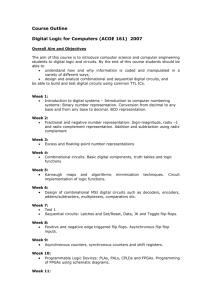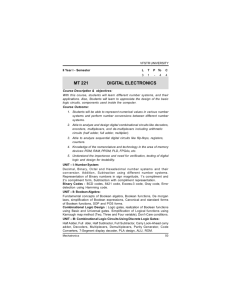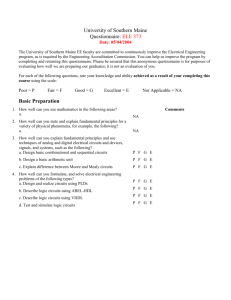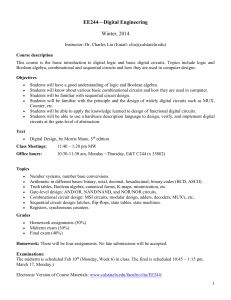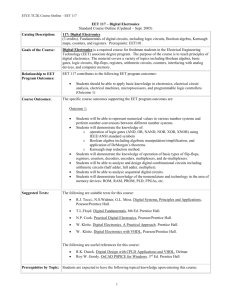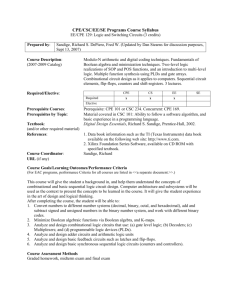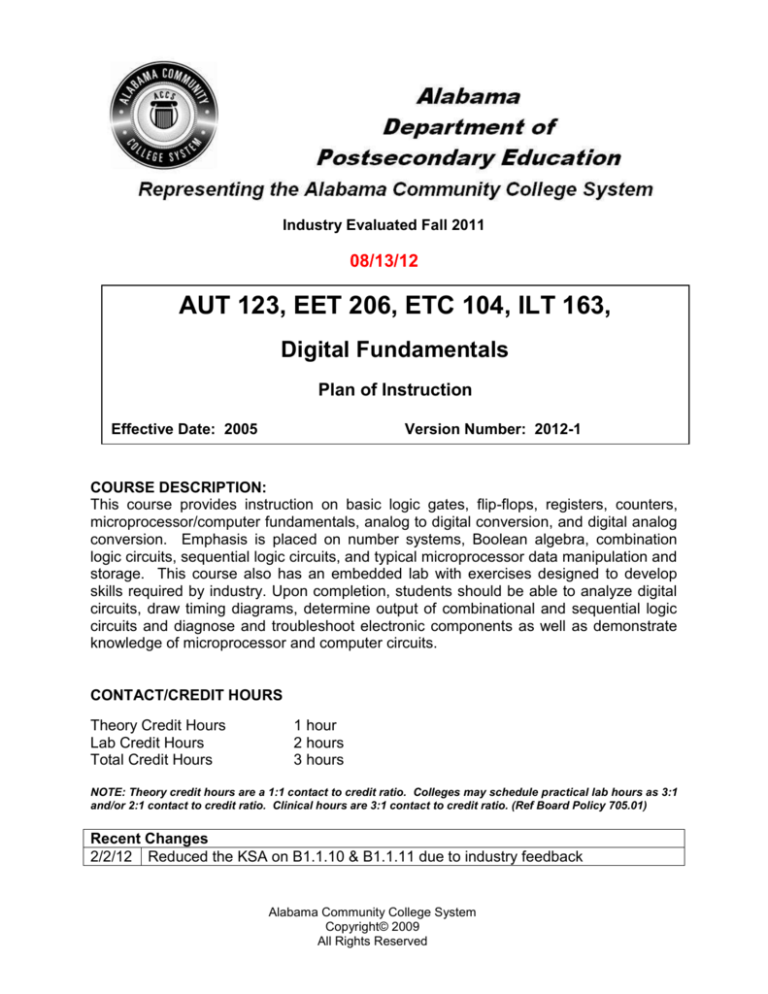
Industry Evaluated Fall 2011
08/13/12
AUT 123, EET 206, ETC 104, ILT 163,
Digital Fundamentals
Plan of Instruction
Effective Date: 2005
Version Number: 2012-1
COURSE DESCRIPTION:
This course provides instruction on basic logic gates, flip-flops, registers, counters,
microprocessor/computer fundamentals, analog to digital conversion, and digital analog
conversion. Emphasis is placed on number systems, Boolean algebra, combination
logic circuits, sequential logic circuits, and typical microprocessor data manipulation and
storage. This course also has an embedded lab with exercises designed to develop
skills required by industry. Upon completion, students should be able to analyze digital
circuits, draw timing diagrams, determine output of combinational and sequential logic
circuits and diagnose and troubleshoot electronic components as well as demonstrate
knowledge of microprocessor and computer circuits.
CONTACT/CREDIT HOURS
Theory Credit Hours
Lab Credit Hours
Total Credit Hours
1 hour
2 hours
3 hours
NOTE: Theory credit hours are a 1:1 contact to credit ratio. Colleges may schedule practical lab hours as 3:1
and/or 2:1 contact to credit ratio. Clinical hours are 3:1 contact to credit ratio. (Ref Board Policy 705.01)
Recent Changes
2/2/12 Reduced the KSA on B1.1.10 & B1.1.11 due to industry feedback
Alabama Community College System
Copyright© 2009
All Rights Reserved
Digital Fundamentals
AUT 123, EET 206, ETC 104, ILT 163
PREREQUISITE COURSES
As determined by college.
CO-REQUISITE COURSES
As determined by college.
PROFESSIONAL COMPETENCIES
Explain safety considerations associated with digital electronics.
Comprehend how various numbering systems affect real life applications.
Comprehend how logic circuits work and how they are simplified through the use
of digital components.
Comprehend how Boolean algebra is used to simplify and save money.
Comprehend how Flip-Flops are used as storage devices and latch circuits.
Comprehend the functions of sequential logic circuits.
Comprehend how combinational logic circuits function in a digital logic
environment.
INSTRUCTIONAL GOALS
Cognitive – Comprehend principles and concepts related to digital electronics.
Psychomotor – Apply principles of digital electronics.
Affective – Value the importance of adhering to policy and procedures related to
digital electronics.
STUDENT OBJECTIVES
Condition Statement: Unless otherwise indicated, evaluation of student’s attainment
of objectives is based on knowledge gained from this course. Specifications may be in
the form of, but not limited to, cognitive skills diagnostic instruments, manufacturer’s
specifications, technical orders, regulations, national and state codes, certification
agencies, locally developed lab/clinical assignments, or any combination of
specifications.
Supported in part by a grant from the National Science Foundation
Advanced Technology Education Program
2
Digital Fundamentals
AUT 123, EET 206, ETC 104, ILT 163
STUDENT LEARNING OUTCOMES
MODULE A – SAFETY
MODULE DESCRIPTION – The purpose of this module is to teach the student the safety
considerations associated with digital electronics. Topics include precautions to be taken
with electrical equipment and digital equipment.
PROFESSIONAL COMPETENCIES
PERFORMANCE OBJECTIVES
KSA
A1.0 Explain safety considerations
A1.1 This competency is measured
2
associated with digital
throughout the course.
electronics.
LEARNING OBJECTIVES
A1.1.1 Explain the safety precautions associated with an electrical environment.
A1.1.2 Explain safety associated with digital equipment and components.
KSA
2
2
MODULE A OUTLINE:
Precautions with electrical equipment
Precautions with digital equipment
MODULE B – NUMBER SYSTEMS AND CODES
MODULE DESCRIPTION – The purpose of this module is to teach the student how
various numbering systems affect real life applications. Topics include digital concepts,
digital logic, number systems, and conversions.
PROFESSIONAL COMPETENCIES
PERFORMANCE OBJECTIVES
KSA
B1.0 Comprehend how various
B1.1 Manipulate DIP switches to
2
numbering systems affect real
perform counting capabilities and
life applications.
take measurements to insure
proper voltage readings using
meters and LEDs.
LEARNING OBJECTIVES
B1.1.1 Explain the digital concept and its application.
B1.1.2 Describe the Elements of Digital Logic.
B1.1.3 Identify the number system and codes applied in digital electronics.
B1.1.4 Explain the number system and codes applied in digital electronics.
B1.1.5 Explain the decimal number system.
B1.1.6 Describe the binary number system.
B1.1.7 Describe how to convert decimal to binary and binary to decimal.
B1.1.8 Explain the hexadecimal number system.
B1.1.9 Convert binary to hexadecimal and hexadecimal to binary.
B1.1.10 Explain the octal number system.
B1.1.11 Convert binary to octal and octal to binary.
B1.1.12 Explain the binary coded decimal number system and its use.
B1.1.13 Convert decimal numbers to binary coded decimal.
Supported in part by a grant from the National Science Foundation
Advanced Technology Education Program
KSA
1
1
2
2
2
2
2
2
2
1
1
2
2
3
Digital Fundamentals
AUT 123, EET 206, ETC 104, ILT 163
B1.1.14 Explain the gray code number system and its use.
B1.1.15 Explain ASCII and EBCDIC alphanumeric codes.
2
2
MODULE B OUTLINE:
Digital concepts
Digital Logic
Number systems
o Decimal
o Binary
o Hexadecimal
o Octal
o Gray code
o ASCII & EBCDIC
Conversions
MODULE C – LOGIC GATES
MODULE DESCRIPTION – The purpose of this module is to teach the students how logic
circuits work and how they are simplified through the use of digital components. Topics
include common logic gates, and symbols.
PROFESSIONAL COMPETENCIES
PERFORMANCE OBJECTIVES
KSA
C1.0 Comprehend how logic circuits C1.1 Construct various logic circuits
2
work and how they are
using specified parts and perform
simplified through the use of
the appropriate validation for each
digital components.
logic circuit.
LEARNING OBJECTIVES
C1.1.1 Explain logical operation and application of logic gates.
C1.1.2 Explain the operation of logic gates; inverters, AND, OR, NAND, NOR,
XOR, and XNOR.
C1.1.3 Recognize standard and alternate logic gate symbols.
C1.1.4 Construct correct truth tables for all logic gates.
C1.1.5 Construct truth tables for gates with more than two inputs.
KSA
2
2
2
2
2
MODULE C OUTLINE:
Logic gates
o Inverters
o AND
o OR
o NAND
o NOR
o XOR
o XNOR
Symbols
Supported in part by a grant from the National Science Foundation
Advanced Technology Education Program
4
Digital Fundamentals
AUT 123, EET 206, ETC 104, ILT 163
Truth tables
Multiple inputs
MODULE D – BOOLEAN ALGEBRA
MODULE DESCRIPTION – The purpose of this module is to teach the student how
Boolean algebra is used to simplify and save money. Topics include Boolean algebra
laws, rules, and conversion.
PROFESSIONAL COMPETENCIES
PERFORMANCE OBJECTIVES
KSA
D1.0 Comprehend how Boolean
D1.1 This competency is measured
1
algebra is used to simplify and
cognitively.
save money.
LEARNING OBJECTIVES
D1.1.1 Apply the basic laws and rules of Boolean algebra to logic circuits.
D1.1.2 Convert between number systems used in digital electronics.
KSA
1
1
MODULE D OUTLINE:
Boolean algebra
o Laws
o Rules
o Conversion
MODULE E – FLIP-FLOPS
MODULE DESCRIPTION – The purpose of this module is to teach the student how FlipFlops are used as storage devices and latch circuits. Topics include Flip-Flops purpose,
latches, switch buffering, contact bounce, storage registers, and JK Flip-Flops.
PROFESSIONAL COMPETENCIES
PERFORMANCE OBJECTIVES
KSA
E1.0 Comprehend how Flip-Flops
E1.1 Construct a flip-flop circuit and
2
are used as storage devices
test for proper operation.
and latch circuits.
LEARNING OBJECTIVES
KSA
E1.1.1 Define Flip-Flops.
E1.1.2 Explain the purpose of Flip-Flops.
E1.1.3 Explain the latches on a Flip-Flop by using truth tables.
E1.1.4 Explain switch buffering and contact bounce.
E1.1.5 Describe storage registers and how they are used.
E1.1.6 Explain how JK Flip-Flops are used as storage elements.
MODULE E OUTLINE:
Flip-Flops
o Purpose
2
2
2
2
2
2
Supported in part by a grant from the National Science Foundation
Advanced Technology Education Program
5
Digital Fundamentals
o
o
o
o
o
AUT 123, EET 206, ETC 104, ILT 163
Latches
Switch buffering
Contact bounce
Storage registers
JK Flip-Flops
MODULE F – SEQUENTIAL LOGIC CIRCUITS
MODULE DESCRIPTION – The purpose of this module is to teach the student the
functions of sequential logic circuits. Topics include counters, shift registers, and clocks.
PROFESSIONAL COMPETENCIES
PERFORMANCE OBJECTIVES
KSA
F1.0 Comprehend the functions of
F1.1 Apply sequential logic functions
2
sequential logic circuits.
related to counters, shift registers,
and clock circuits.
LEARNING OBJECTIVES
F1.1.1
F1.1.2
F1.1.3
F1.1.4
F1.1.5
F1.1.6
F1.1.7
F1.1.8
Define counters.
Explain the function of counters.
Explain the code used by counters.
Describe asynchronous counters.
Identify the function and movement of a shift register.
Explain the serial to parallel conversions of a shift register.
Describe the basic types of MOS shift registers.
Define the function of a clock oscillator circuit.
KSA
2
2
2
2
2
2
2
2
MODULE F OUTLINE:
Counters
Shift Registers
Clocks
The following module is optional provided time is available.
MODULE G – COMBINATIONAL LOGIC
MODULE DESCRIPTION – The purpose of this module is to teach the student how
combinational logic circuits function in a digital logic environment. Topics include
Encoders, Multiplexers, Demulitplexers, exclusive ORs and ROM.
PROFESSIONAL COMPETENCIES
PERFORMANCE OBJECTIVES
KSA
G1.0 Comprehend how
G1.1 Construct a combinational logic
2
combinational logic circuits
circuit and test for proper
function in a digital logic
operation.
environment.
LEARNING OBJECTIVES
Supported in part by a grant from the National Science Foundation
Advanced Technology Education Program
KSA
6
Digital Fundamentals
AUT 123, EET 206, ETC 104, ILT 163
G1.1.1
G1.1.2
G1.1.3
G1.1.4
G1.1.5
G1.1.6
G1.1.7
G1.1.8
Explain the functions of Decoders and Encoders.
Differentiate between Decoders and Encoders.
Explain BCD to 7-segment display Decoder.
Explain the operations of Multiplexers and Demultiplexers.
Differentiate between Multiplexers and Demultiplexers.
Identify the symbol and truth tables of exclusive OR logic circuits.
Explain how ROM operations work with memory circuits.
Explain how to convert analog signals to digital and digital signals to
analog.
MODULE G OUTLINE:
Decoders
Encoders
Mulitplexers
Demulitiplexers
Exclusive ORs
ROM
Conversions
2
2
2
2
2
2
2
2
Reference: Digital Techniques; Heath Kit EB-6201-A(Text Book), EB 6201-41(Lab Book) EB
6201-31(Lab Kit)
LEARNING OUTCOMES TABLE OF SPECIFICATIONS
The table below identifies the percentage of learning objectives for each module.
Instructors should develop sufficient numbers of test items at the appropriate
level of evaluation.
Limited
Knowledge and
Proficiency
1
Module A
Module B
Module C
Module D
Module E
Module F
Module G
31%
Moderate
Knowledge
and
Proficiency
2
100%
69%
100%
Advanced
Knowledge
and
Proficiency
3
Superior
Knowledge
and
Proficiency
4
100%
100%
100%
100%
Supported in part by a grant from the National Science Foundation
Advanced Technology Education Program
7
Digital Fundamentals
Indicator
1
2
3
4
AUT 123, EET 206, ETC 104, ILT 163
Learner’s Knowledge, Skills and Abilities
Key Terms
Description
Identifies basic facts and terms about the subject or
competency.
Limited
Knowledge Performs simple tasks associated with the
and
competency. Needs to be told or shown how to do
Proficiency
most tasks.
Requires close supervision.
Identifies relationship of basic facts and states
general principles and can determine step-by-step
Moderate
procedures for doing the competency.
Knowledge
and
Performs most parts of the competency. Needs help
Proficiency
only on hardest parts.
Requires limited supervision.
Analyzes facts and principles and draws conclusions
about the subject to include why and when the
Advanced
competency must be done and why each step is
Knowledge
needed. Can predict outcomes.
and
Performs all parts of the competency. Needs only a
Proficiency
spot check of completed work.
Requires little or no direct supervision.
Can evaluate conditions and make appropriate
Superior
decisions as related to resolving problems.
Knowledge
Performs competency quickly and accurately with no
and
direct supervision and is able to instruct and
Proficiency
supervise others.
Supported in part by a grant from the National Science Foundation
Advanced Technology Education Program
8

